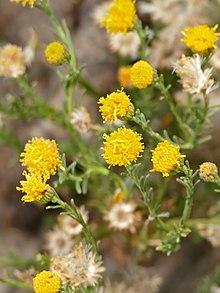
Native to South Africa and Namibia, this aromatic subshrub is a member of the aster family, Asteraceae, that also includes sunflower, yarrow, and lettuce. The plants form dense bushy mounds with horizontal, fibrous stems that form roots at ground level and then grow erect. Growing 12-24″ tall, the plants have grayish, pinnately compound leaves that are egg or wedge-shaped, covered with matted hairs, and resemble pine needles. The terminal yellow flowerheads are ball-like, 1/2″ across, and consist of disc flowers enclosed in graduated phyllaries. They appear from spring into summer and give way to 5-angled achenes with cup-shaped, dry, crowns of scales. The shrubs are highly valued as fodder for sheep in arid and semi arid areas and are given credit for the unique taste of Karoo lamb. They were introduced into southwestern US during the Dust Bowl to stabilize the soil. The genus name, Pentzia, honors Swedish plant collector Hendrik Christian Pentz (1738–1803). The specific epithet, incana, is the Latin word meaning hoary or white and refers to the appearance of the foliage.
Type: Subshrub
Outstanding Feature: Fodder plant for sheep
Form: Rounded
Growth Rate: Slow to moderate
Bloom: Yellow flowerheads .5″ across from spring into summer
Size: 12-24″ H
Light: Full sun
Soil: Sandy, dry, well-drained
Hardiness: Zones 11-12
Care: Low maintenance
Pests and Diseases: None of significance
Propagation: Seed, stem cuttings
Outstanding Selections: None available
Photo Credit: Wikipedia